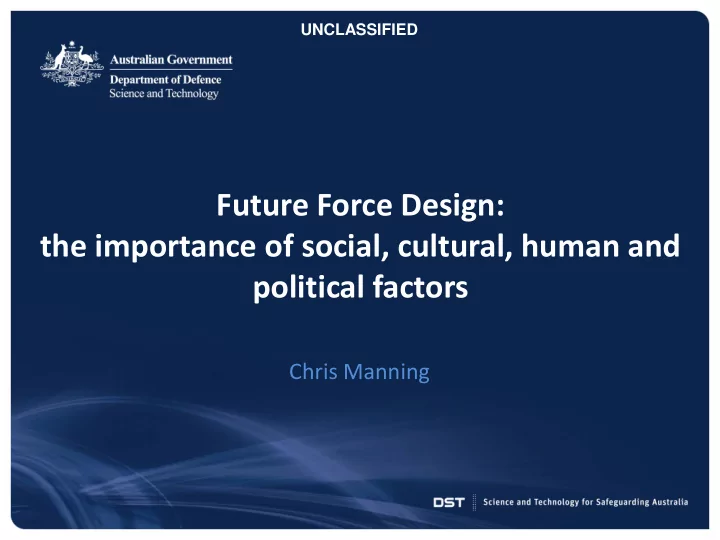

UNCLASSIFIED Future Force Design: the importance of social, cultural, human and political factors Chris Manning 1
Outline Call to arms Background – Modelling Complex Warfighting, Strategic Research Initiative – Strategic Response 4: Modelling Complex Human Systems under Uncertainty Collaboration opportunities – “Complex systems design” Conclusion 2
Call to arms Drivers – First Principles Review – Force Design Process – Capability Life Cycle Changes – Future Operating Environment and trends in future warfare • Emerging technology • Contested urban environments • Robotic and autonomous systems Given the rapid change to a highly networked cyber world, how does the ADF ensure it isn’t optimising for the wrong war? 3
Creating the Future Force PREPARE AND DESIGN AND CONNECTED EMPLOY THE DEVELOP THE THROUGH CURRENT FUTURE FORCE TIME FORCE 4
Modelling Complex Warfighting (MCW) DST Group is launching the MCW Strategic Research Initiative. It forms part of the CDS-sponsored strategic research program. It draws on JOAD’s operations analysis capabilities and experience supporting individual domains. Through partnership with academia and industry the SRI will revolutionise the application of OA to future force design. Revolutionise Enhance Operations Force Design Analysis 5
Modelling Complex Warfighting Research Themes Scientific methods to enable robust Force Design decisions to produce a Conquering resilient force through the understanding and management of Uncertainty uncertainty in Defence. Innovative Novel modelling and simulation techniques to enable exploration of whole-of-force warfighting concepts and force options. simulations Knowledge Synthesis of analytical and simulation results to support development of synthesis a joint force which is integrated by design. Modelling Methods to enable understanding of properties of the joint force emerging complexity as a result of nonlinear interactions between the many constituent elements. 6
MCW SRI: Strategic Responses (SR) Conquering SR 4: Modelling complex human systems Uncertainty SR7: Modelling unknowns Innovative SR 5: Capability decision evaluation under uncertainty simulations Knowledge SR 3: Force design data life cycle synthesis Modelling SR 6: Concepts for complexity-enabled warfare complexity SR 2: Simulation-based concept exploration SR 1: Machine discovered behaviour Current Force Future Force Time Horizon (years ) 0 10 20 7
SR4: Modelling Complex Human Systems under Uncertainty Holistic analysis including social, cultural, human and political factors Comprehensive understanding, impacts and insights of force design options and effects Aims – Develop suite of methods to analyse and synthesise uncertainty of future operating environment and force design – Framework for operationalisation of factors and inclusion in force design process 8
Complex Systems Design Complex Systems Design is an “umbrella” term for candidate tools that could be applied to Land Force Design Ranging from – Interpret/develop strategy and guidance (SODA) – Emergent design (Systemic Design) – Iterative design (Adversarial Scenario Analysis) Bridging the gap from – Understanding the environment (Futures & Scenario Analysis) – Evaluating (Wargaming and Red Teaming) 9
An Example Enable the Land Force to effectively operate in an irreducibly uncertain future . – Transform the Land Force to avoid strategic shock – Build and test future Land Force in a Joint context – Ensure the combined arms team of the future is a robust, adaptive and potent force optimised for sustained close combat – Support development of Land Force Strategy and Concepts – Support the development of Land Force structures – Understand the future land operating environment to hedge against unacceptable risk – Enable more informed decision making – Partnership for conceptual analysis • ADF provide SMEs (creative thinkers) and DST in collaboration with industry/academia provide framework to apply S&T rigour (lead analysis) 10
Novel and Creative options (Land Force examples) Proposed design principles – Adopt distributed operations framework – Embrace expeditionary philosophy – Seek independent self-contained combat teams – Embrace unconventional warfare/irregular warfare – Embrace full multi-dimension manoeuvre – Employ reach back as a key enabler to offset “Light” – Effects driven vs Terrain focussed – “Whilst light, carry a big stick” – Emphasize Phase 0 operations to shape the Battlespace early 11
Novel and Creative options (Land Force examples) Codename: FireAnt – A mindset for design of future structures and operating concepts – a small, agile, swarming force that would strike terror into adversaries even if they were larger 12
Novel and Creative options (Land Force examples) Develop concepts that inform novel ways to fight and integrate Information Warfare into the broader operational campaign – Design force options that enhance the Future Force’s ability to • shape and influence • disrupt adversaries’ will to fight • defend against and exploit emerging technologies (eg social media, robotic and autonomous systems, precision strike) 13
Applied Research Use CSD methods to develop and propose force structures and concepts designed to operate in a complex and uncertain future Apply CSD to explore creative and novel options for Land Force Design 14
Collaboration Opportunities Aims 1. Develop “design” capability and holistic analytical methodologies for whole of force 2. Embed, evaluate and refine these approaches within the Defence environment (support contestability focus) Expected outcomes – Improve scientific rigour applied to Defence problems and achieve better outcomes for Defence – Enhance engagement and create opportunities for partnership – Support publication of research outcomes – Further development and application of methods and techniques – Improve understanding and integration of interplay between non- material (social, cultural, human and political) and material (technological and infrastructure) factors to better inform force design 15
Conclusion Keen to expand the range of methods available – Engage with us beyond initial candidates (Systemic Design and SODA) for Complex Systems Design Timeframe – 3-5 year research proposal – But want outcomes immediately 6-12 months Learn by doing – apply existing methods to new areas or develop new methods – Build skills through practical application to real Defence problems (Force Design) 16
Questions 17
Recommend
More recommend